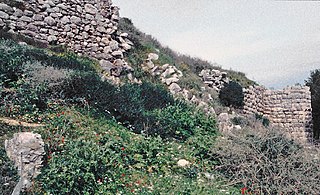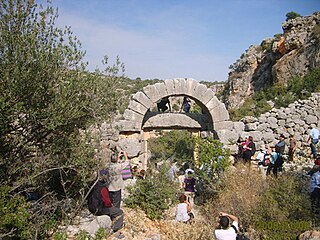Related Research Articles

Asine was an ancient Greek city of ancient Argolis, located on the coast. It is mentioned by Homer in the Catalogue of Ships in the Iliad as one of the places subject to Diomedes, king of Argos. It is said to have been founded by the Dryopes, who originally dwelt on Mount Parnassus. In one of the early wars (740 BCE) between the Lacedaemonians and the Argives, the Asinaeans joined the former when they invaded the Argive territory under their king Nicander; but as soon as the Lacedaemonians returned home, the Argives laid siege to Asine and razed it to the ground, sparing only the temple of the Pythaëus Apollo. The Asinaeans escaped by sea; and the Lacedaemonians gave to them, after the end of the First Messenian War, a portion of the Messenian territory, where they built a new town. Nearly ten centuries after the destruction of the city its ruins were visited by Pausanias, who found the temple of Apollo still standing.
Triopium or Triopion and Triopia was a town on the coast of ancient Caria, near ancient Cnidus. According to ancient writers Triopas was the founder of the city, and took its name after him.

Selinus or Selinous was a port-town on the west coast of Rough Cilicia and later of Isauria, at the mouth of a small river of the same name, now called Musa Çay. It is located west of the modern city of Gazipaşa in Turkey.

Nisa, also Nyssa (Νύσσα) or Nysa (Νύσα) or Neisa (Νείσα), was a town in ancient Lycia near the source of the River Xanthus.
Chalcetor or Chalketor was a town of ancient Caria. Strabo says that the mountain range of Grion is parallel to Latmus, and extends east from the Milesia through Caria to Euromus and the Chalcetores, that is, the people of Chalcetor. In another passage, Strabo names the town Chalcetor, which some writers have erroneously altered to Chalcetora. It was a member of the Delian League. The city united in the 2d century BC with Euromus, and later in a sympolity with Mylasa.
Arsada or Arsadus was a city of ancient Lycia, located over the valley of the Xanthus between the ancient cities of Tlos and Xanthus.
Istlada was a town of ancient Lycia; the name is known only from inscriptions and is uncertain because the end of the inscription has been lost.
Lissa was a town of ancient Lycia, mentioned by Ptolemy.
Lydae or Lydai was a town of ancient Caria or Lycia in the Rhodian Peraea. Ptolemy notes the city in Lycia under the name Chydae. The Stadiasmus Maris Magni calls the city Clydae or Klydai (Κλυδαί) and places it in Caria.
Teimiussa, also spelt Teimioussa or Timiussa, also known as Tristomon, was a port town of ancient Lycia, near the ancient settlement Tyberissus. The name is not attested in history, but is derived from epigraphic and other evidence. This combination of harbor and inland location is the focus of archaeological exploration. Among the finds are ancient tombs.
Tyberissus or Tyberissos, also Tyberisus or Tyberisos, was an inland town of ancient Lycia, near the ancient settlement of Teimiussa that functioned as its port. The name is not attested in history, but is derived from epigraphic and other evidence. This combination of harbor and inland location is the focus of archaeological exploration. Among the finds are tombs with Lycian inscriptions. Coins inscribed "ΤΥ" of typical Lycian type were probably minted here.
Trysa or Tryssa was a town of ancient Lycia, located between Cyaneae and Myra. It has been archaeologically examined, and among the finds are Lycian tombs, most notably the Heroon of Trysa. Greek inscriptions which were found there show that there was a cult of Zeus Eleutherios and of Helios at Trysa. The town was also inhabited during the Byzantine period and there was a church on the acropolis.
Castabus or Kastabos was a town of ancient Caria. Diodorus says Hemithea was carried off by Apollo and deified at Castabus. The city came under Rhodian control, as part of the Rhodian Peraia, no later than 300 BC. In 1960, an ancient Greek sanctuary dedicated to the demigod Hemithea was discovered near the city by the British archaeologists J.M. Cook and W.H. Plommer. The sanctuary consists of a temple, a theatre and numerous houses. The theatre follows the common typical layout of Greek theatres, with a wide koilon (auditorium) and a small scene-building.
Zephyrium or Zephyrion, also called Zephyrium on the Calycadnus to differentiate it from other towns called Zephyrium, was a town of ancient Cilicia on the Calycadnus River near its mouth, on a promontory of the same name.
Magarsa, or Magarsus or Magarsos (Μάγαρσος), or Megarsus or Megarsos (Μέγαρσος), was a town in the eastern part of ancient Cilicia, situated on a height close to the mouth of the river Pyramus. Alexander the Great, previous to the Battle of Issus, marched from Soli to Megarsus, and there offered sacrifices to Athena Megarsis, and to Amphilochus, the son of Amphiaraus, the reputed founder of the place. It seems to have formed the port of Mallus. It was later re-founded and renamed in Hellenistic times as Antiochia ad Pyramum.
Pseudokorasion was a town of ancient Cilicia, on the coast a little to the east of Seleucia ad Calycadnum, inhabited during the Hellenistic, Roman and Byzantine eras.

Korasion, also called Kalon Korakesion, was a town of ancient Cilicia, on the coast a little to the east of Seleucia ad Calycadnum, inhabited during the Roman and Byzantine eras.
Arima, also called Krine, was a town of ancient Cilicia, on the coast east of Seleucia ad Calycadnum. Arima was noted in Greek Mythology in connection with Typhon and Arima, couch of Typhoeus.
Corycium Antrum was an inland town of ancient Cilicia, above Arima, inhabited during the Byzantine era.
Kalanthia was a coastal town of ancient Cilicia, inhabited during the Roman and Byzantine eras.
References
- 1 2 3 Richard Talbert, ed. (2000). Barrington Atlas of the Greek and Roman World . Princeton University Press. p. 66, and directory notes accompanying. ISBN 978-0-691-03169-9.
- ↑ Lund University. Digital Atlas of the Roman Empire.




